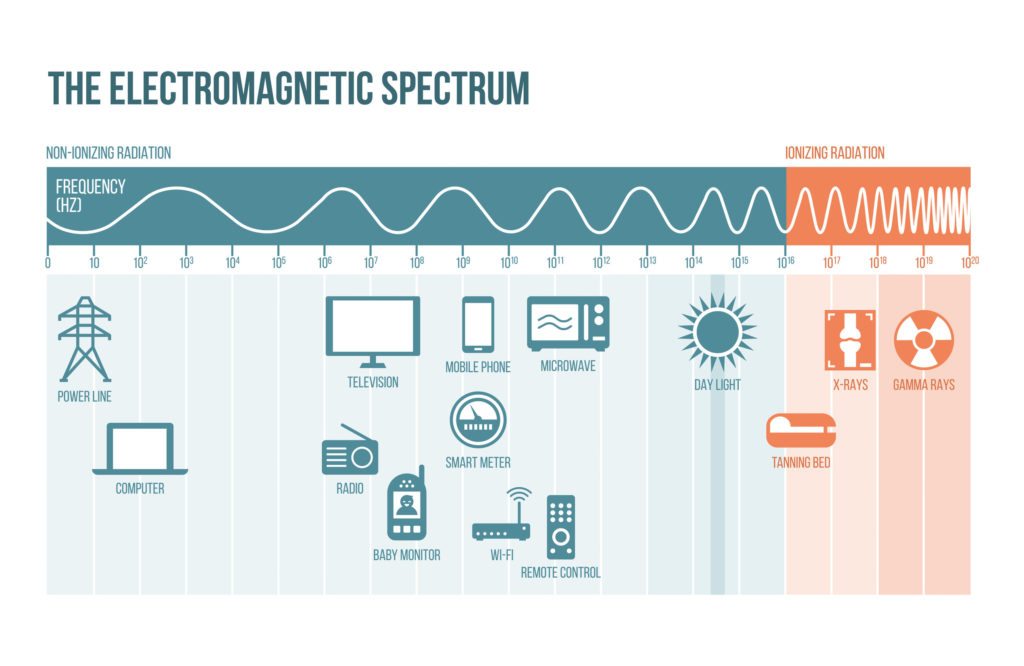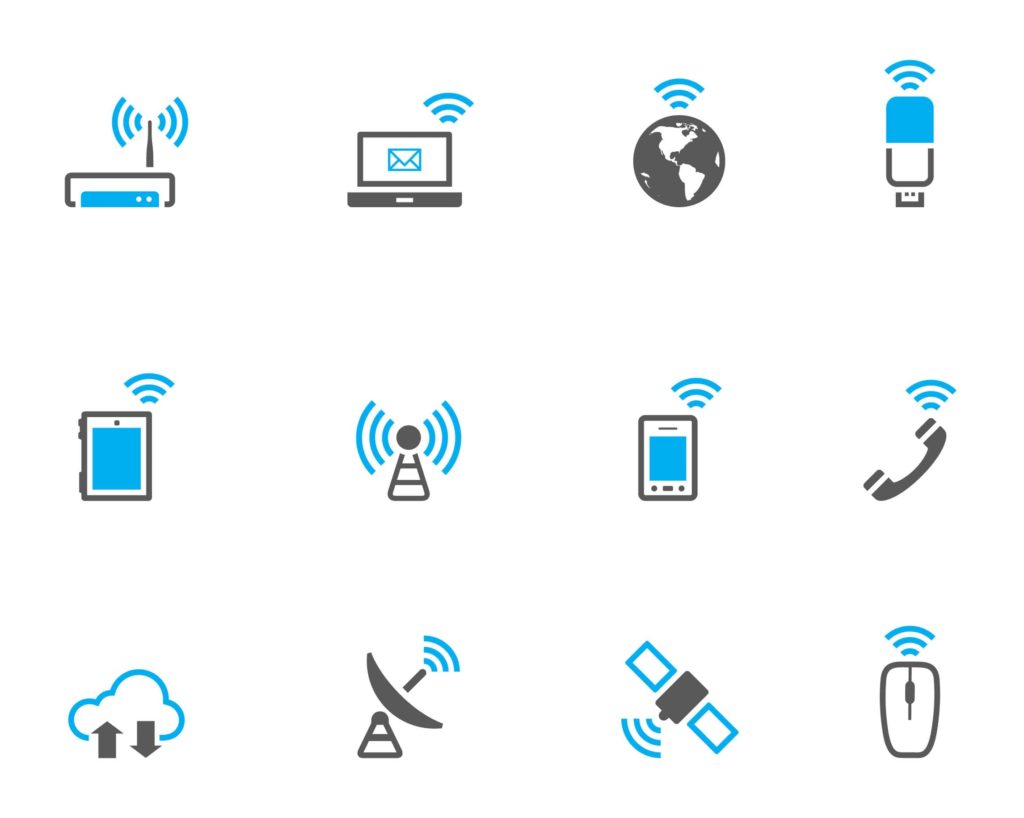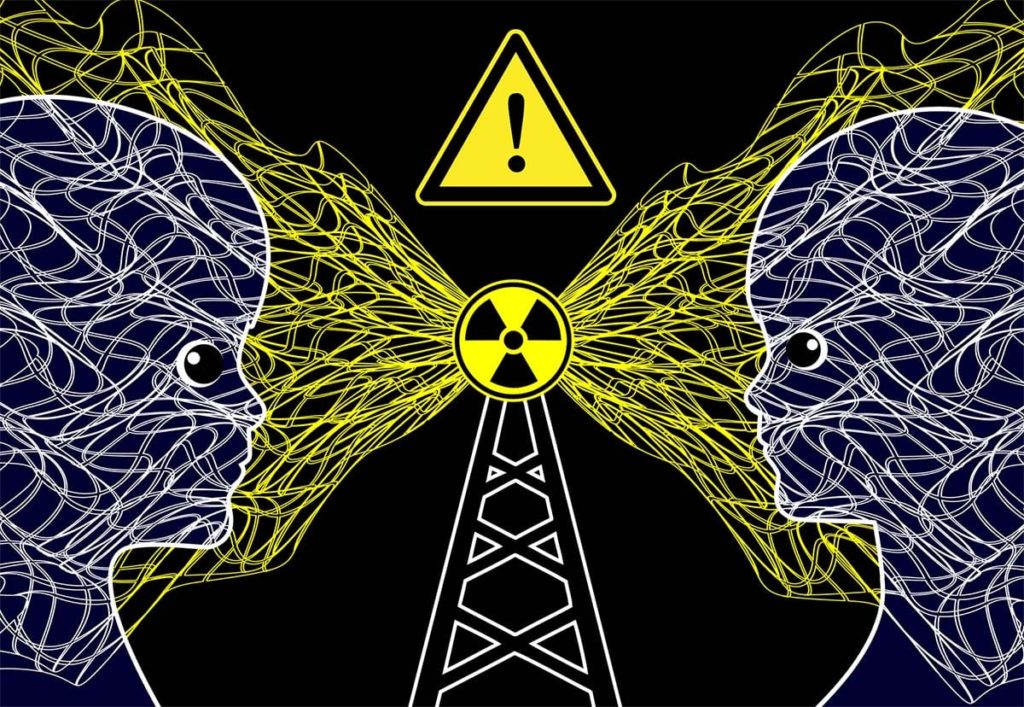What is EMF
EMF radiation travels in waves of energy that permeates the air and everything around us. Often compared to waves in the ocean, EMF waves can have properties that move fast and with tightly formed waves with high crests which will carry substantial amounts of energy or can be slow moving and elongated like ripples that carry smaller amounts of energy. Instead of water as the medium, it is energy flowing everywhere in the environment. Only a small fraction of EMFs are visible to the human eye in the form of light. The majority of EMF radiation is invisible to us although it is ubiquitous in the environment.
EMF radiation can be produced in natural environments such as solar energy and geomagnetic fields or unnaturally transmitted from manufactured sources. Natural EMF radiation surrounds us every day in the form of heat and light which is crucial for the survival of human beings and other organisms. The unnatural sources of EMF radiation are generated from electrical lines, transmission towers, telecommunications, home appliances, mobile devices, WIFI, and “smart” devices. Various forms of unnatural manufactured EMFs are filling our environment more rapidly every day with the expanse of wireless technology and communications. Currently, both sources of radiation, natural as well as manufactured, almost equally contribute to the total radiation pool that surrounds us.
EMF energy levels are measured on a spectrum of frequencies in relation to wave properties in physics. Two major categories on the EMF spectrum that refer to the level of energy carried by certain frequencies called ionizing radiation (high level) and non-ionizing radiation (low level). Ionizing radiation is well known as the dangerous part of the EMF spectrum with frequency bands that include UV rays, X-rays, and gamma rays. It is well known to avoid exposure to ionizing radiation because it can damage tissue and break the bonds of DNA molecules inside of living cells. Non-ionizing radiation is the lesser-known part of the spectrum and is increasingly being artificially introduced by technological advancements in human society. Health implications of non-ionizing EMF have been mostly ignored in the past because they were previously considered too low energy to cause harm. Currently, there is a ubiquitous proliferation of wireless technology that is bombarding the environment with a variety of manufactured EMF frequencies which are nearly inescapable. Since plants and animals absorb these EMFs there may be many implications for the future of the environment and human health.
References:
Frey, A. H. (1988). Evolution and Results of Biological Research with Low-Intensity Nonionizing Radiation (1st ed.). CRC Press.
Gherardini, L., Ciuti, G., Tognarelli, S., & Cinti, C. (2014). Searching for the perfect wave: the effect of radiofrequency electromagnetic fields on cells. International journal of molecular sciences, 15(4), 5366-5387.
Guleria, R., Bhushan, B., Guleria, A., Bhushan, A., & Dulari, P. (2019). Harmful effects of ionizing radiation. International Journal for Research in Applied Science and Engineering Technology, 7(12), 887-889.

In recent history, human beings have harnessed powers of modern science to create electricity and communication technologies. This technology has led to the electrified modern era with all the wonderful benefits and limitless capabilities innovation gives to us. In the past century, the proliferation of electricity and technology raised standards of living and exploded the earth’s population at least tenfold. Electricity and technology are an enormously powerful thing and need to be treated with responsibility and caution for humanity to reap the benefits while minimizing potential drawbacks.
Currently, we are in a new era of technology where communication and information are wirelessly transmitted and beamed around seemingly by magic. Unfortunately, it is not magic, and there is surprisingly little known in the mainstream about what is carrying the amazing levels of energy that power and connect all our technology. These EMFs come from manufactured energy sources that permeate the environment around us to arrive at our homes, businesses, and wireless devices.
Technology can be beneficial and enjoyable to have in our lives, but everyone needs to be aware of the type of physical energy being used and their impact on the environment in which we live. There is an abundance of technology now being hastily introduced into our environment without rigorous testing of potential hazards from EMF exposure. Concern over potential negative impacts of EMF exposure is growing among scientists and health professionals alike who are attempting to spread awareness and calling on governments to act.
References:
Belpomme, D., & Irigaray, P. (2020). Electrohypersensitivity as a newly identified and characterized neurologic pathological disorder: How to diagnose, treat, and prevent it. International journal of molecular sciences, 21(6), 1915.
Belpomme, D., & Irigaray, P. (2022). Why electrohypersensitivity and related symptoms are caused by non-ionizing man-made electromagnetic fields: An overview and medical assessment. Environmental Research, 113374.
Gherardini, L., Ciuti, G., Tognarelli, S., & Cinti, C. (2014). Searching for the perfect wave: the effect of radiofrequency electromagnetic fields on cells. International journal of molecular sciences, 15(4), 5366-5387.
Pall, M. L. (2021). Millimeter (MM) wave and microwave frequency radiation produce deeply penetrating effects: the biology and the physics. Reviews on Environmental Health.

When scientists speak of EMF emissions from electricity and communication technology, they are often referring to unnatural non-ionizing EMFs which are increasingly being artificially pumped into the environment. These unnatural and manufactured EMF frequencies are polarized, pulsed, modulated, and beam around our environment to reach our wireless devices. Human beings have not experienced these types of EMFs throughout our entire evolutionary history; so, it is raising concerns among scientists and health professionals. Depending on the specific frequency, intensity, and modulation being used there can be a variety of different reactions that can affect the biology of plants and animals including human beings.
Extremely Low Frequency or “ELF” often comes from power lines, household wiring and appliances as well as electronic equipment in our homes. These sources produce magnetic fields that penetrate deep into the body and have been long suspected to cause diseases such as cancer and motor neuron disease.
Radio frequency radiation or “RFR” is non-ionizing EMF that traditionally carried signals from transmission towers over great distances to receivers which has existed for over a century for radio communication and later TV broadcasting. However, the more recent expanse of technology from the wireless industry has put powerful transmitters and receivers much closer to users. Those sources of RFR are growing exponentially around us in the form of laptops, tablets, cellphones, Bluetooth devices, WIFI routers, and anything claiming to be a “smart device.”
Currently, with the introduction of fifth generation mobile antennas (5G) we are entering a new era for RFR called Millimeter Wave or Microwave Frequencies (MMW). Instead of miles of signal being emitted from distant towers with previous generations of RFR, there will be many more 5G transmitters and receivers placed closely together irradiating every house and public building to every street corner. It will use an array of directional, steerable, beam-forming antennae that operate at higher power then previous generations. Unfortunately, potential health impacts from 5G technology have not been studied by governments or safety authorities for health effects before approving the rapid rollout across the world.
References:
Frey, A. H. (1988). Evolution and Results of Biological Research with Low-Intensity Nonionizing Radiation (1st ed.). CRC Press.
Gherardini, L., Ciuti, G., Tognarelli, S., & Cinti, C. (2014). Searching for the perfect wave: the effect of radiofrequency electromagnetic fields on cells. International journal of molecular sciences, 15(4), 5366-5387.
Hardell, L., & Sage, C. (2008). Biological effects from electromagnetic field exposure and public exposure standards. Biomedicine & pharmacotherapy, 62(2), 104-109.
Kostoff, R. N., Heroux, P., Aschner, M., & Tsatsakis, A. (2020). Adverse health effects of 5G mobile networking technology under real-life conditions. Toxicology Letters, 323, 35-40.
Moskowitz, J. (2017). 5G wireless technology: millimeter wave health effects. Electromagnetic Radiation Safety, 3, 3-6.
Pall, M. L. (2021). Millimeter (MM) wave and microwave frequency radiation produce deeply penetrating effects: the biology and the physics. Reviews on Environmental Health.
Sofri, T., Rahim, H. A., Abdulmalek, M., Abd Rani, K., Omar, M. H., Yasin, M. N. M., ... & Soh, P. J. (2021). Health Effects of 5G Base Station Exposure: A Systematic Review. IEEE Access.

An evolving body of research is implicating EMF radiation from technology as an environmental pollution with many potential health consequences. Recently, regulators are being called out by health experts around the world to address the evolving evidence of a potential health crisis. To date, there have been numerous studies that have shown links between manufactured EMFs and adverse health effects; especially for fetuses and children. Alarmingly, the vulnerable biology of fetuses and children are not considered at all when setting safety standards to limit EMF emissions from wireless devices. In addition, current regulation standards only address the thermal paradigm that causes direct heating of tissue from short term of EMF exposure. On the other hand, non-thermal effects in the long term from manufactured EMFs are not considered by regulation authorities despite mounting evidence of such. The long term implications from non-thermal effects to biology are of greatest concern for health experts since they pose the greatest risk to health. Also, non-thermal effects shown by many researchers to have health risks associated at much lower levels than are legally set by current safety limits.
Meanwhile, corrupt officials are denying the need for further regulation while basing their decisions on incoherent and outdated science. In fact, the existing public health safety standards were set by regulators decades ago without considering new evidence from reputable research studies done recently. This problem is evolving into a public controversy due to government authorities unrelenting denial of science against the interest of public health. Substantiated and blatant disregard for health science displayed by government agencies and technology companies is now posing a huge threat to human health. This has spurred many health experts and advocates to explore legal action and expose the motives of lucrative technology industries and their subservient government bureaucrats.
References:
Alster, N. Captured Agency.
Belpomme, D., & Irigaray, P. (2022). Why electrohypersensitivity and related symptoms are caused by non-ionizing man-made electromagnetic fields: An overview and medical assessment. Environmental Research, 113374.
Belyaev, I., Dean, A., Eger, H., Hubmann, G., Jandrisovits, R., Kern, M., Kundi, M., Moshammer, H., Lercher, P., Müller, K., Oberfeld, G., Ohnsorge, P., Pelzmann, P., Scheingraber, C. & Thill, R. (2016). EUROPAEM EMF Guideline 2016 for the prevention, diagnosis and treatment of EMF-related health problems and illnesses. Reviews on Environmental Health, 31(3), 363-397. https://doi.org/10.1515/reveh-2016-0011
Blank, M. (2012). The cellular stress response: EMF-DNA interaction. Prepared for the BioInitiative Working Group. Section7.
Di Ciaula, A. (2018). Towards 5G communication systems: Are there health implications?. International journal of hygiene and environmental health, 221(3), 367-375.
Hardell, L., & Carlberg, M. (2020). [Comment] Health risks from radiofrequency radiation, including 5G, should be assessed by experts with no conflicts of interest. Oncology Letters, 20(4), 1-1.
Hardell, L., & Sage, C. (2008). Biological effects from electromagnetic field exposure and public exposure standards. Biomedicine & pharmacotherapy, 62(2), 104-109.
International Commission on Non-Ionizing Radiation Protection. (2020). Guidelines for limiting exposure to electromagnetic fields (100 kHz to 300 GHz). Health physics, 118(5), 483-524.
Kostoff, R. N., Heroux, P., Aschner, M., & Tsatsakis, A. (2020). Adverse health effects of 5G mobile networking technology under real-life conditions. Toxicology Letters, 323, 35-40.
Pall, M. L. (2021). Millimeter (MM) wave and microwave frequency radiation produce deeply penetrating effects: the biology and the physics. Reviews on Environmental Health.
Pall, M. L. (2015). How to approach the challenge of minimizing non-thermal health effects of microwave radiation from electrical devices. Int. J. Innov. Res Eng. Manag (IJIREM), 2(5), 71-76.
Stein, Y. (2021). Preventive measures to reduce harmful effects produced by electromagnetic radiation on health. Health Risk Analysis, (3), 42-53.

Many health experts in the U.S. and abroad have complained and petitioned government agencies requesting them to readdress safety standard laws to reflect new compelling evidence of health risks. Currently government agencies are ignoring a multitude of very credible research studies in order to maintain the status quo. That includes suppressing a 25-million-dollar long term study from the National Toxicology Program (NTP) that was requested by the EPA decades ago which reports evidence of serious health risks due to wireless technology. Health scientists consistently point to economic conflicts of interest that compel government agencies to cover up health risks in order to reap benefits from the technology industry. Consequently, government agencies avoid appointing health science experts to regulate for safety standards and instead appoint engineers and physicists that are not qualified to interpret health research. As health professionals get systemically ignored in favor of untethered expansion of technology the risks to human health hangs in the balance.
References:
Alster, N. Captured Agency.
Hardell, L., & Carlberg, M. (2020). [Comment] Health risks from radiofrequency radiation, including 5G, should be assessed by experts with no conflicts of interest. Oncology Letters, 20(4), 1-1.
Hardell, L., & Sage, C. (2008). Biological effects from electromagnetic field exposure and public exposure standards. Biomedicine & pharmacotherapy, 62(2), 104-109.
Kostoff, R. N., Heroux, P., Aschner, M., & Tsatsakis, A. (2020). Adverse health effects of 5G mobile networking technology under real-life conditions. Toxicology Letters, 323, 35-40.

Watch these videos on EMF radiation!
Don’t Miss Out!
GET 10% OFF OF YOUR FIRST PURCHASE
Get the latest on Sales, Special Offers, New Releases and more

